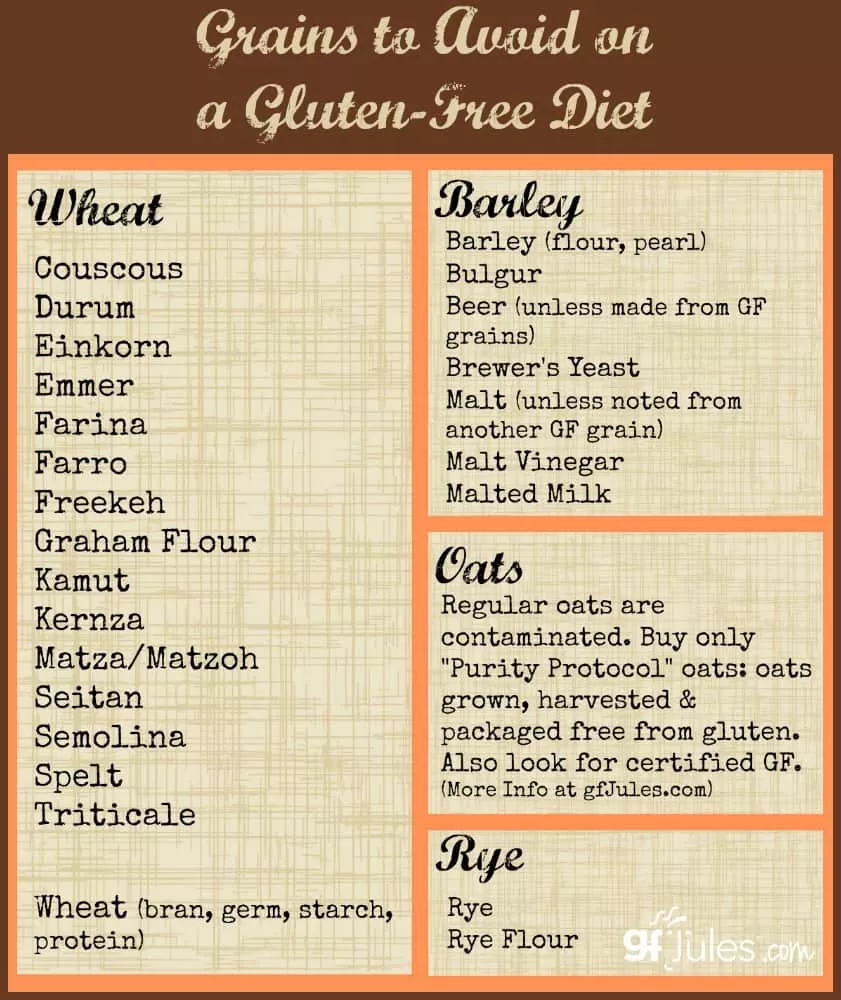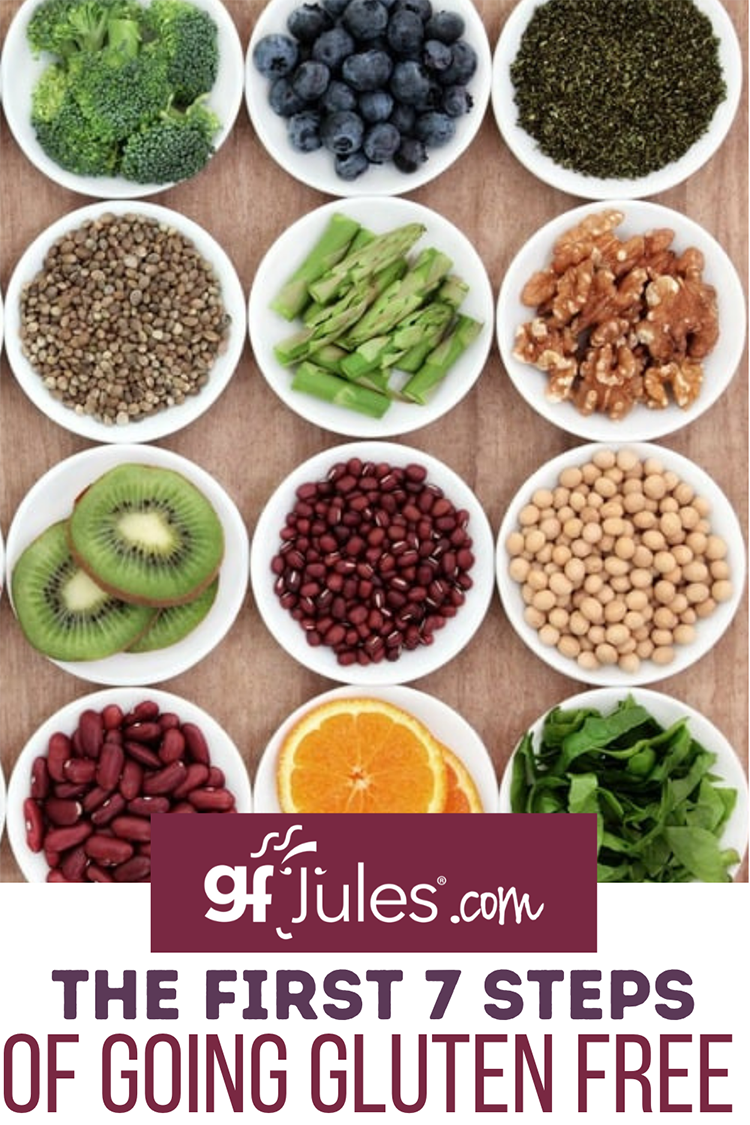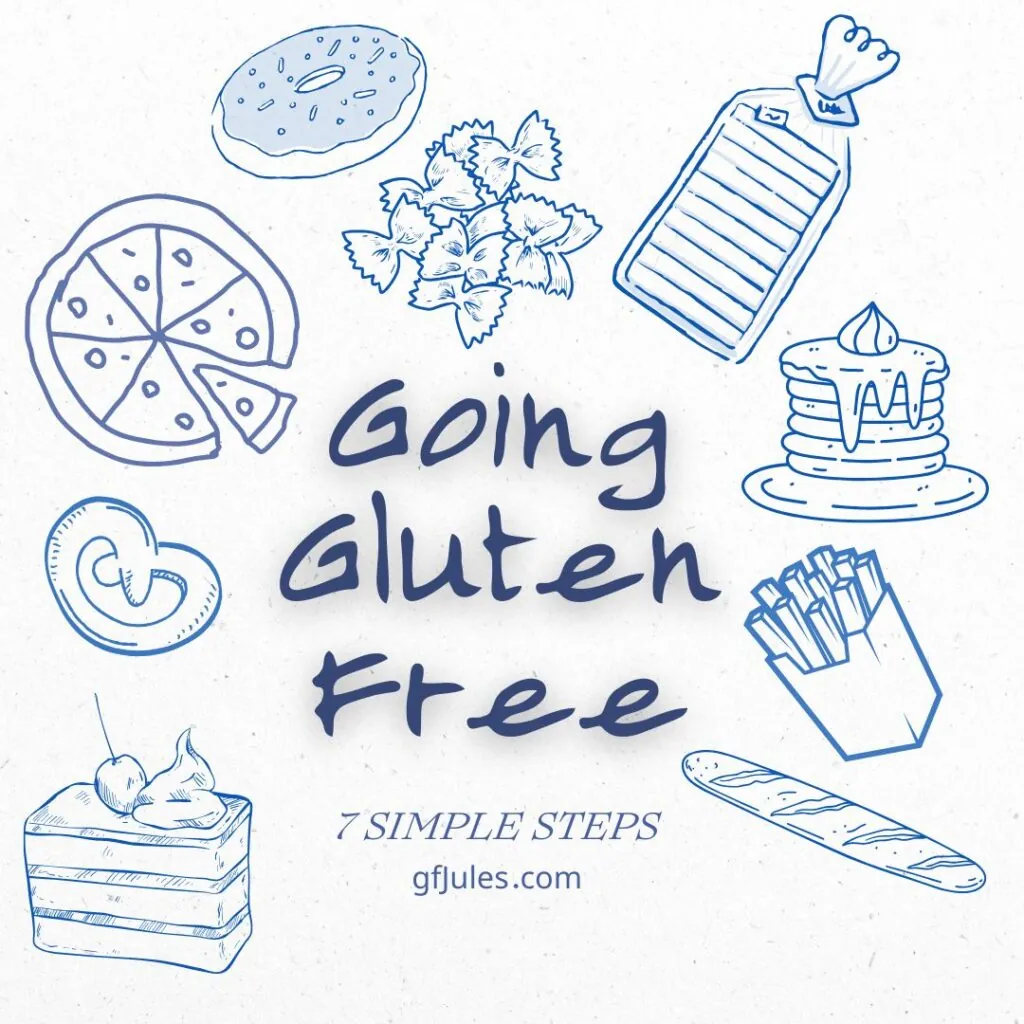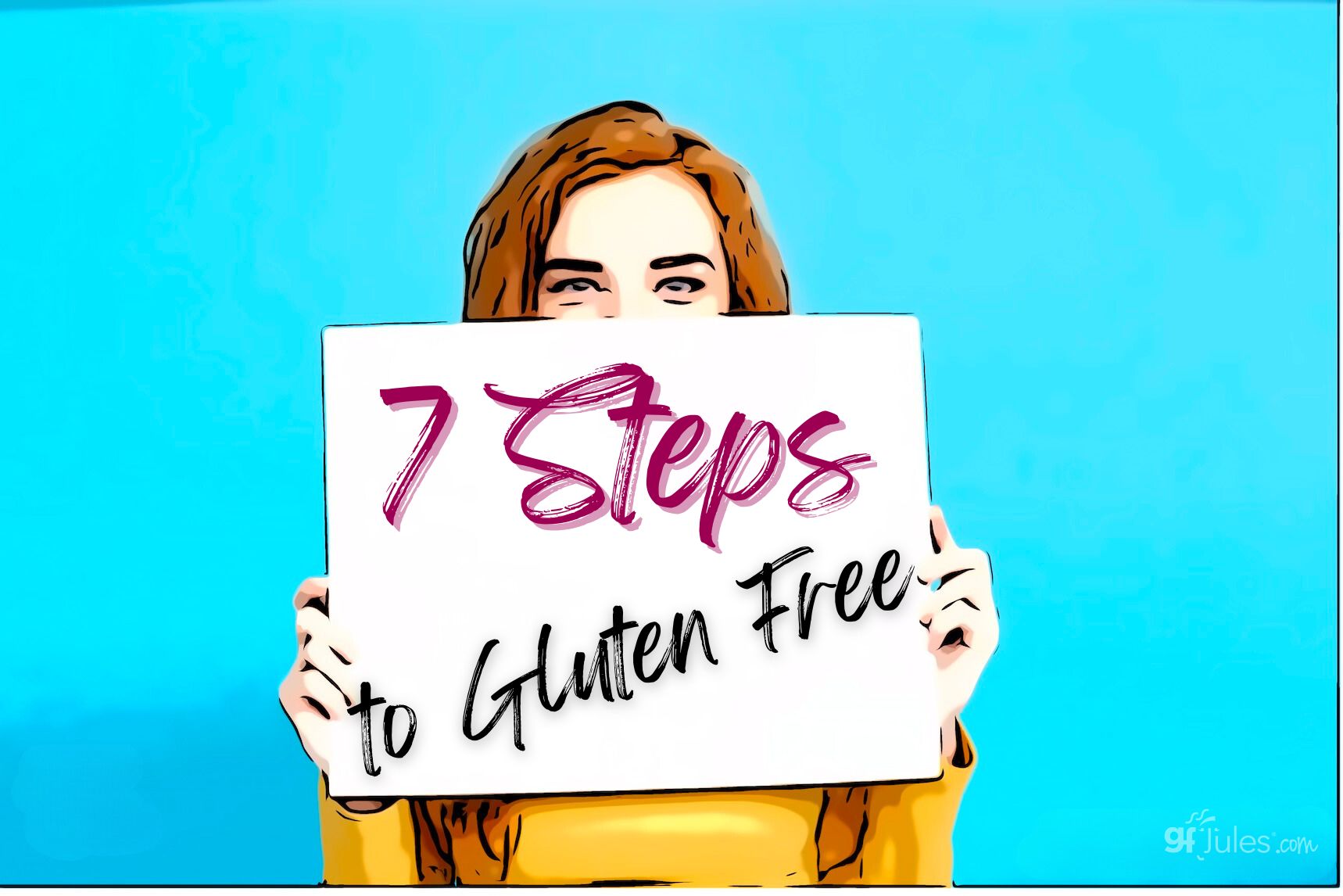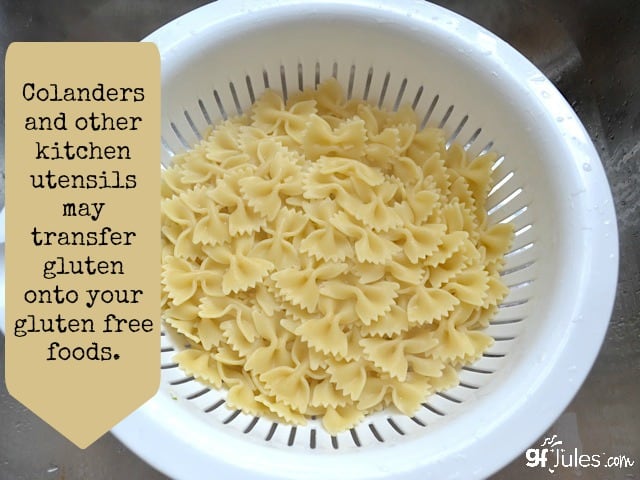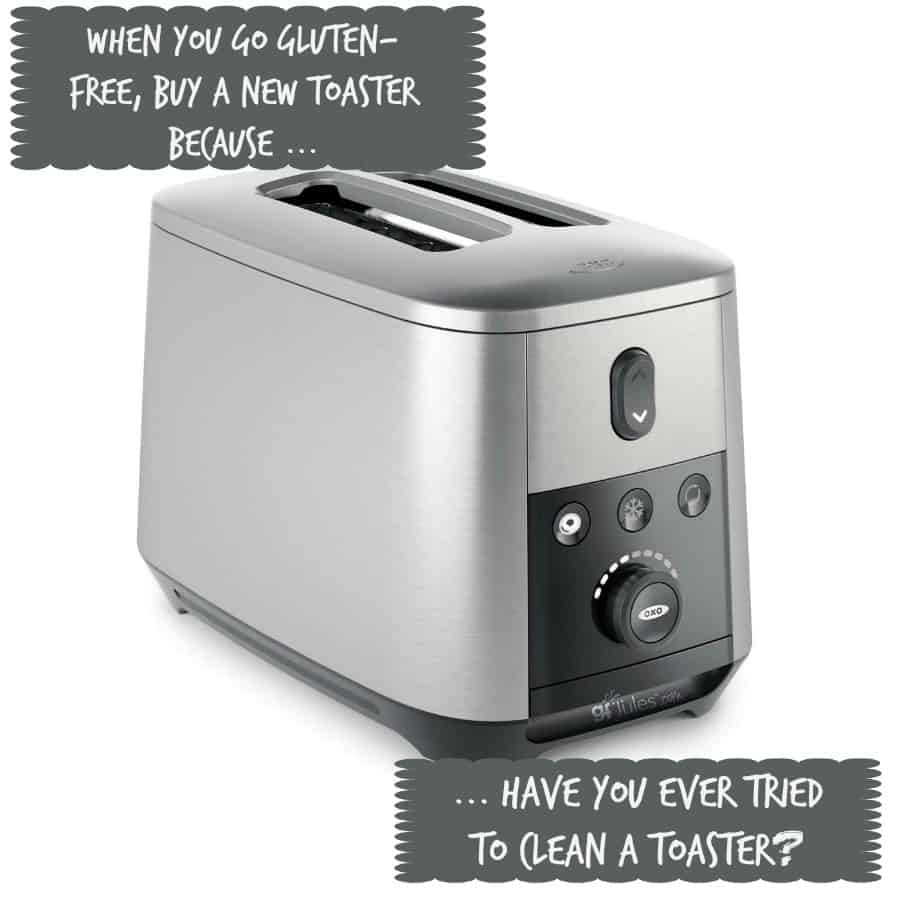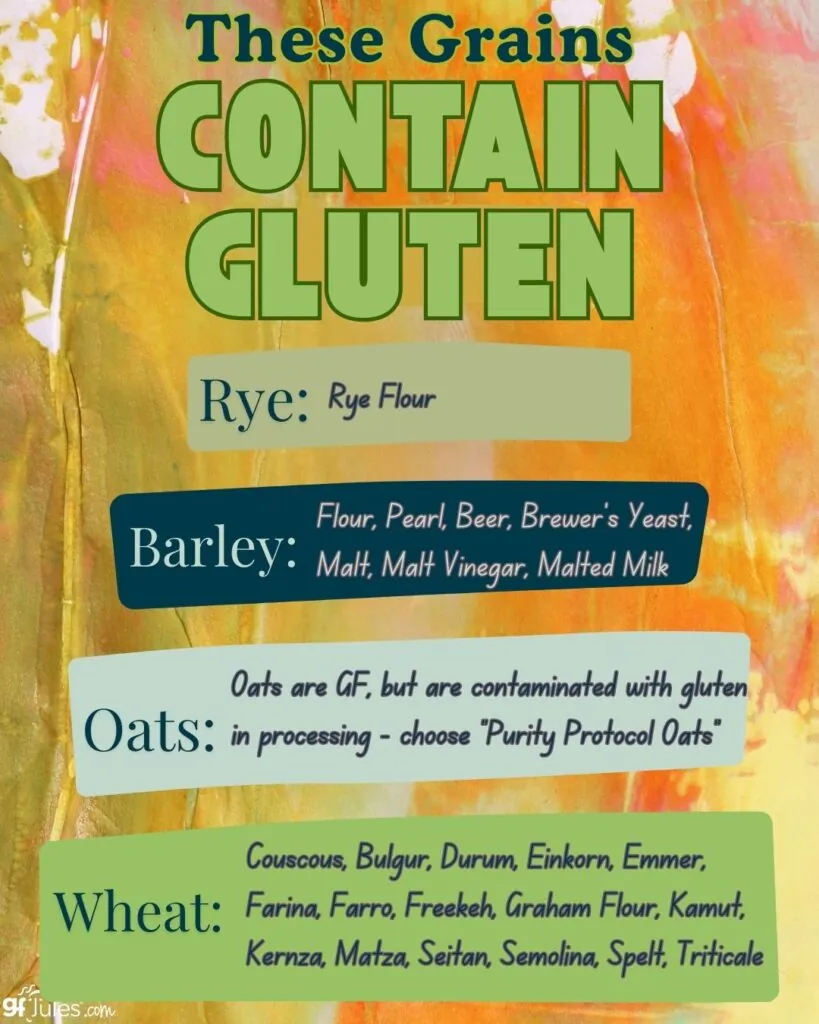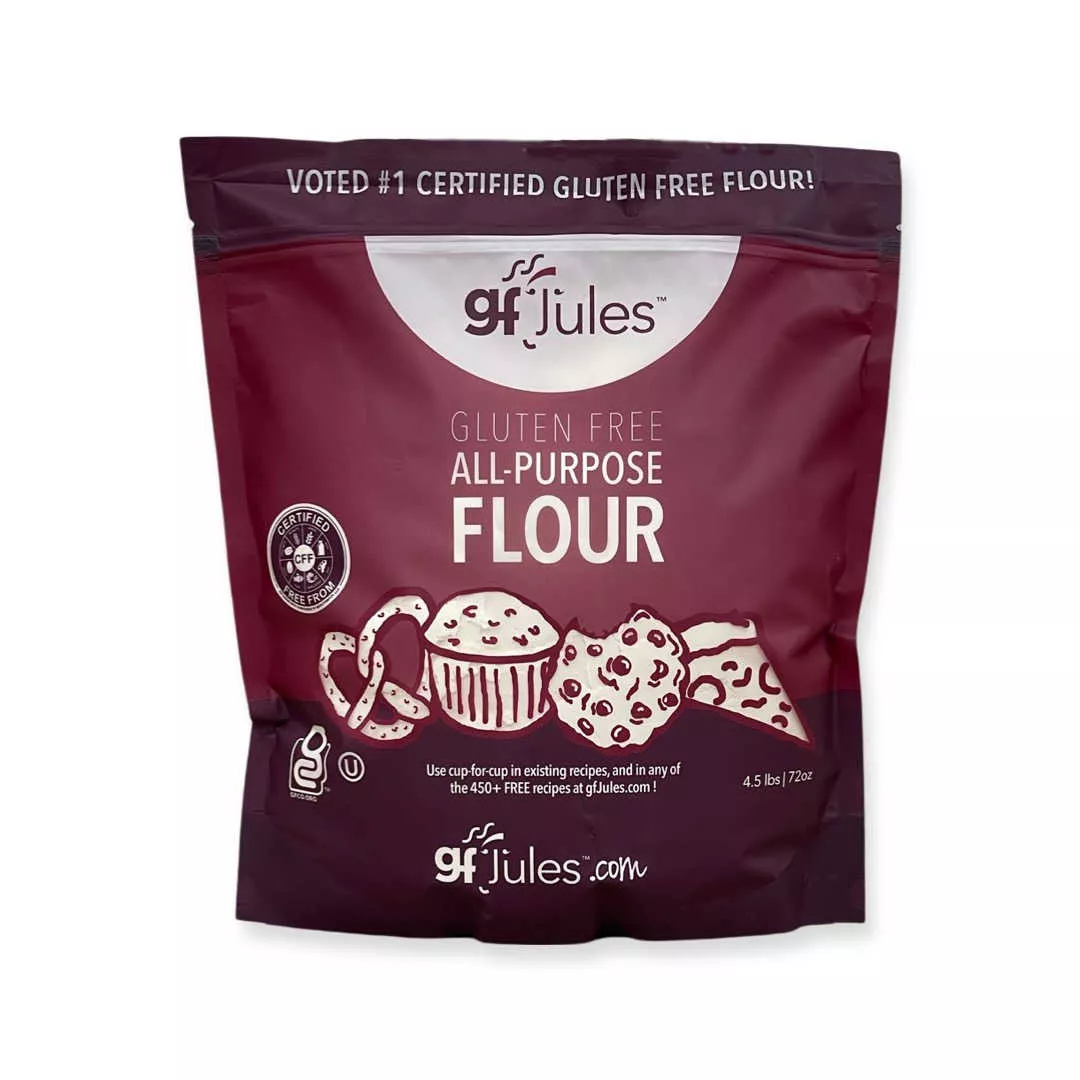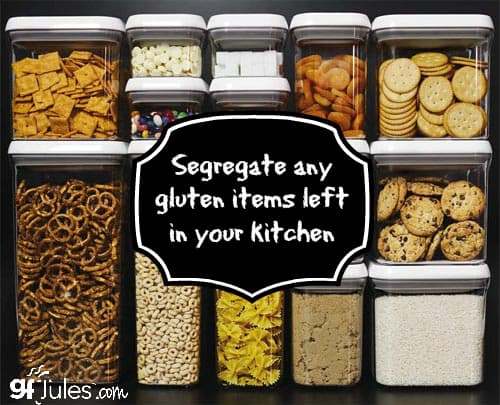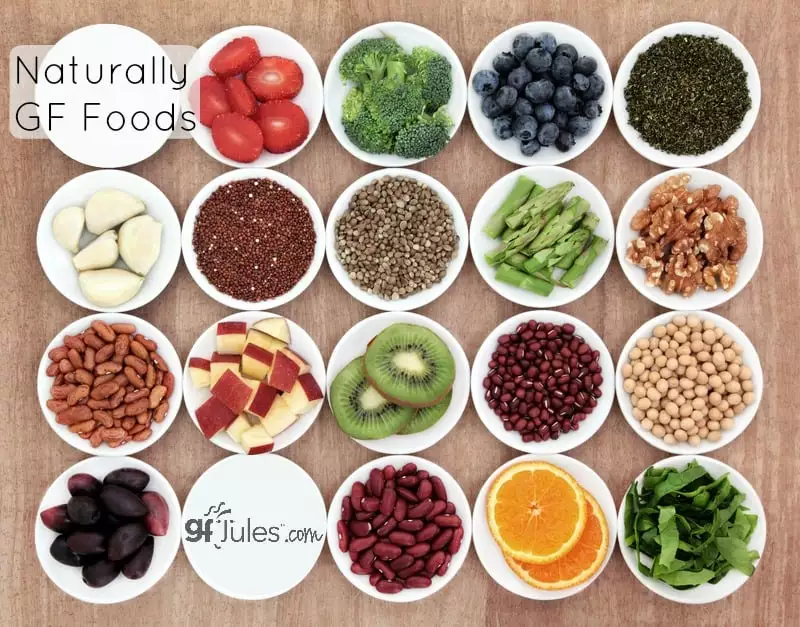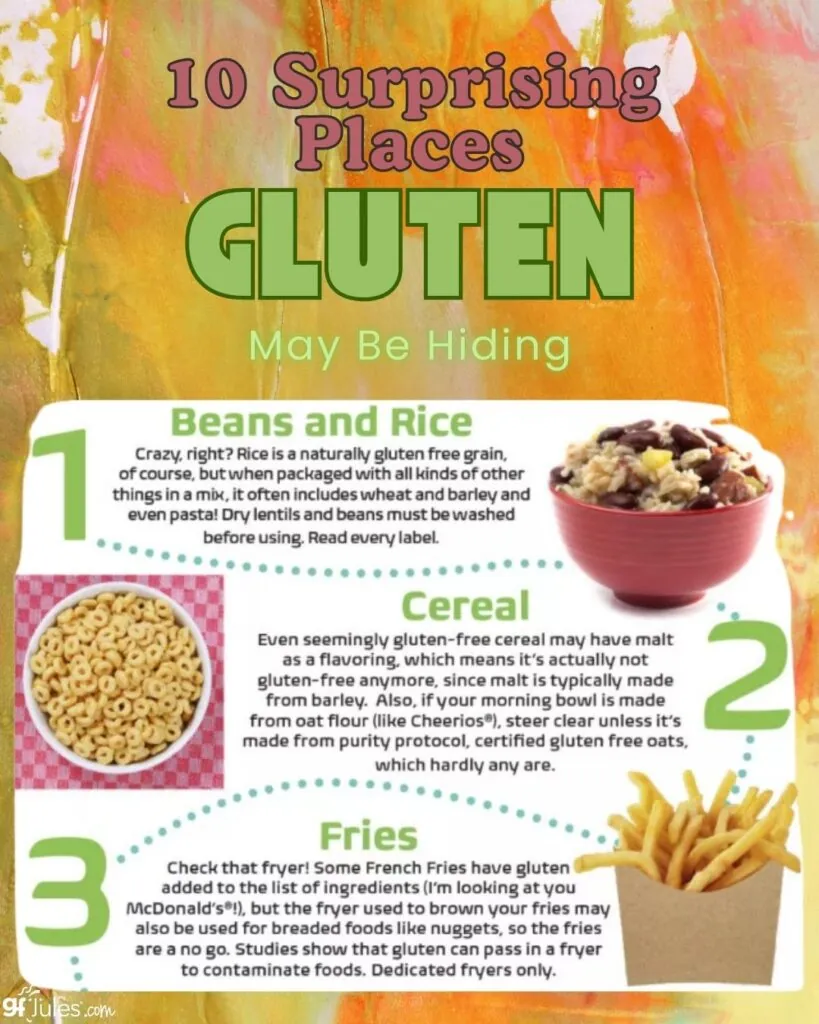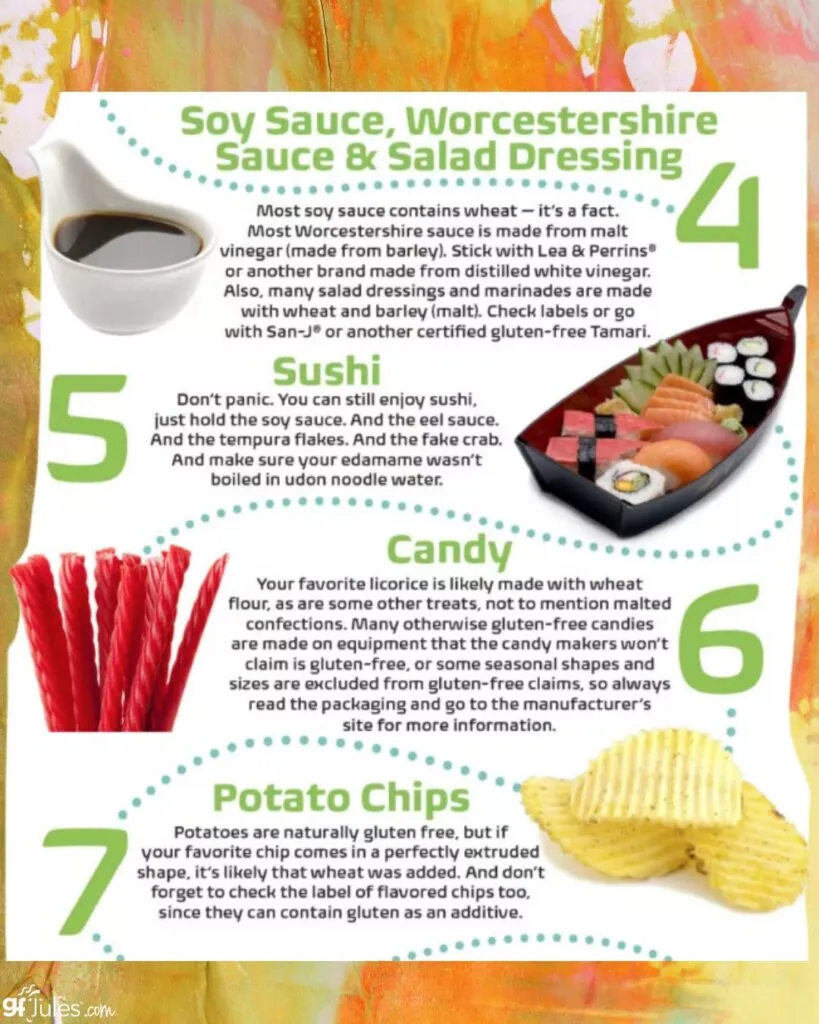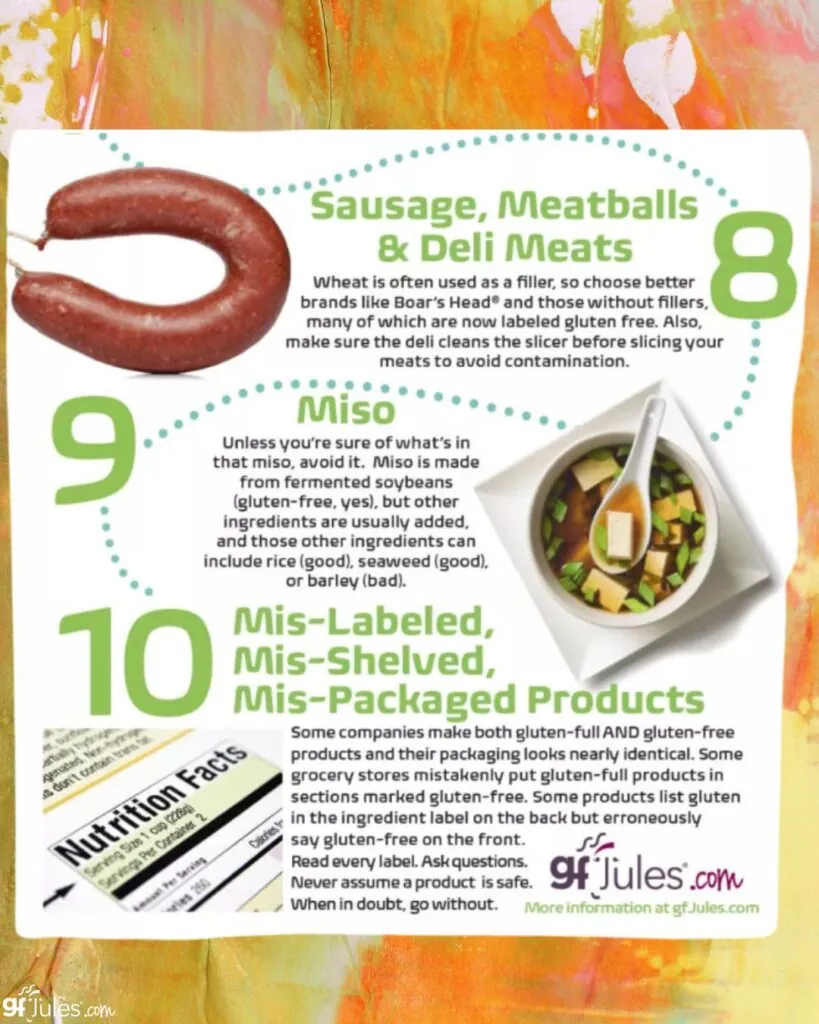How Do I Go Gluten Free?
When you’ve decided you’re going gluten free, you start in your kitchen. It’s Food Central, right? Whether it’s large or galley, stocked or empty, your new gluten free kitchen will be your safe zone.
Your gluten free kitchen will become the place where you can always find and make yummy and safe gluten free foods. When your kitchen is going gluten free too, then you won’t be tempted to “cheat” by eating gluten–because there won’t be other options.
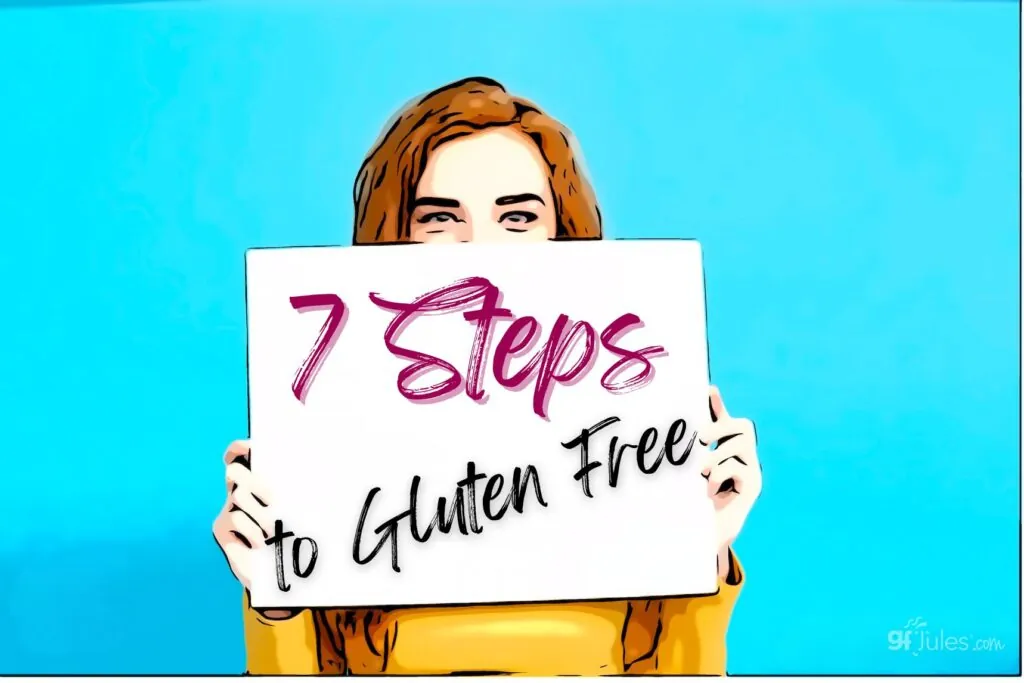
To create this safe zone, you need to set it up right from the beginning. Below are 7 tips for going gluten free quickly and easily.
Incorporating gluten-free alternatives is essential for maintaining a healthy and balanced diet, especially for those with celiac disease, non-celiac gluten sensitivity, or gluten intolerance.
Each step is crucial when you’re going gluten free. Take the time to do it correctly, thoroughly, from the start. A solid foundation will make everything else fall into place with much less stress.
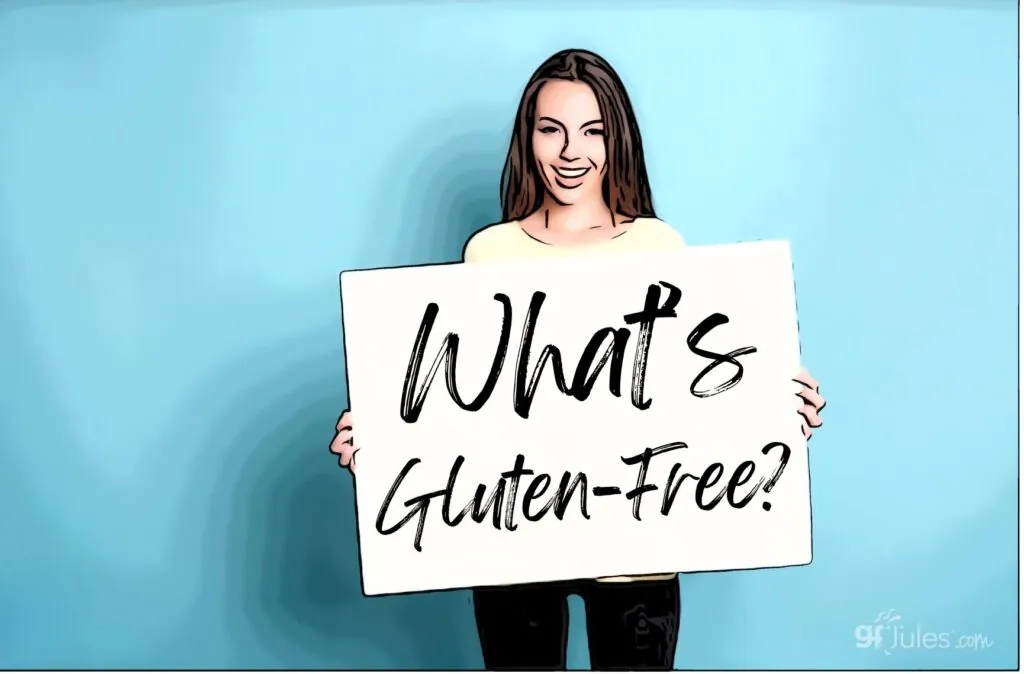
What Does Gluten Free Mean?
So we’re all on the same page, when we say “gluten free” we mean less than 20 parts per million (ppm) gluten. This amount is a proportion of the food you are eating.
It’s difficult to imagine, but it’s like visualizing a drop of food coloring in a gallon bucket of water. It’s generally accepted that up to 10 milligrams of gluten per day does not harm most people, but not all, with celiac disease, however some people with extreme gluten sensitivity cannot even tolerate 0.4 mg gluten/day without adverse effects.

Many people following a gluten free diet do still ingest some gluten — either from small amounts (less than 20 ppm) in labeled gluten free foods or from cross-contact with other foods.
What does cross-contact look like? A one-ounce slice of bread made with regular flour can contain 28,359mg of gluten; just a few crumbs from that bread can contain well over 10mg gluten (1/350th of a slice).
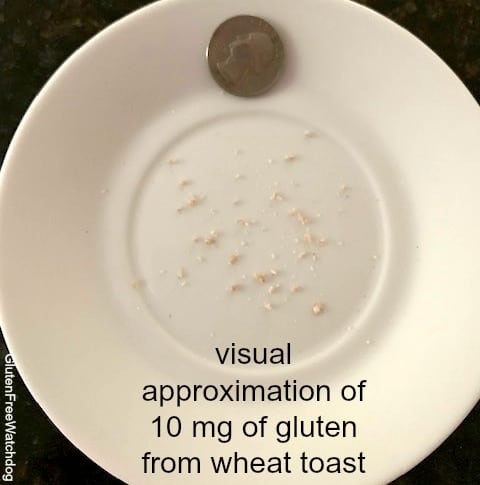
Here’s a visual representation from Gluten Free Watchdog of what 10 milligrams of gluten in wheat bread looks like. I highly recommend reading her entire article to see representations of just how little bread it would take to equal 10 milligrams of gluten.
This fact becomes particularly relevant when considering cross-contact with gluten in co-mingled kitchens.

So, if a food actually contained 20 parts per million of gluten, in order to eat a full 10 milligrams of gluten from that food, you would have to eat a half kilogram (1 pound!) of that food.
That’s about 1/2 of one large pineapple, so you can picture it (try eating that in one sitting!).

Therefore, the amount of the food eaten is important. One cracker with 20 ppm gluten contains a lot less gluten than a burrito with 20 ppm gluten. Keep this in mind when we discuss safe food choices.
Tricia Thompson at Gluten Free Watchdog describes the importance of amount of food when discussing low gluten communion wafers:
Regarding the low gluten hosts, please keep in mind that we are talking about a wafer that weighs approximately 33 milligrams. To put this in perspective, a one ounce slice of bread is the same as 28,350 milligrams. A one ounce slice of gluten-free bread containing just under 20 parts per million of gluten contains a little over 1/2 milligram of gluten (0.57 milligrams). The amount of gluten in one host is approximately 0.0019 milligrams.
So, What is Gluten?
Gluten is a food protein found in the grains wheat, barley (malt) and rye. Where it gets more complicated is that there are plenty of other cousin grains which contain gluten, too. Remember this list of grains to avoid and use it to shop safely by reading every label and every menu closely:
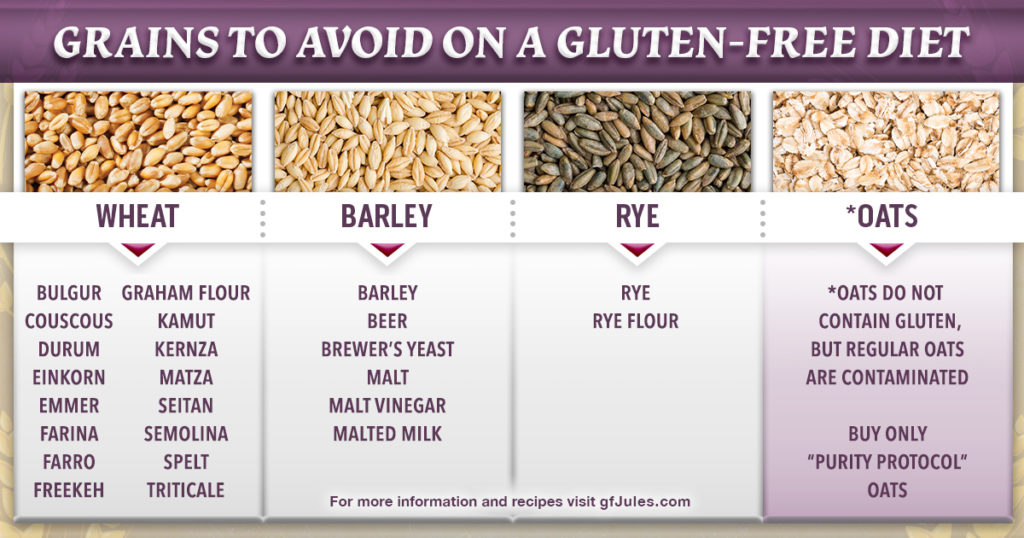
For more information on identifying and shopping for Purity Protocol, safe gluten-free oats, hop to my article on gluten free oats here.
Given what you’ve just read (and committed to memory, right?), can you spot the gluten-free menu fail on this menu below?
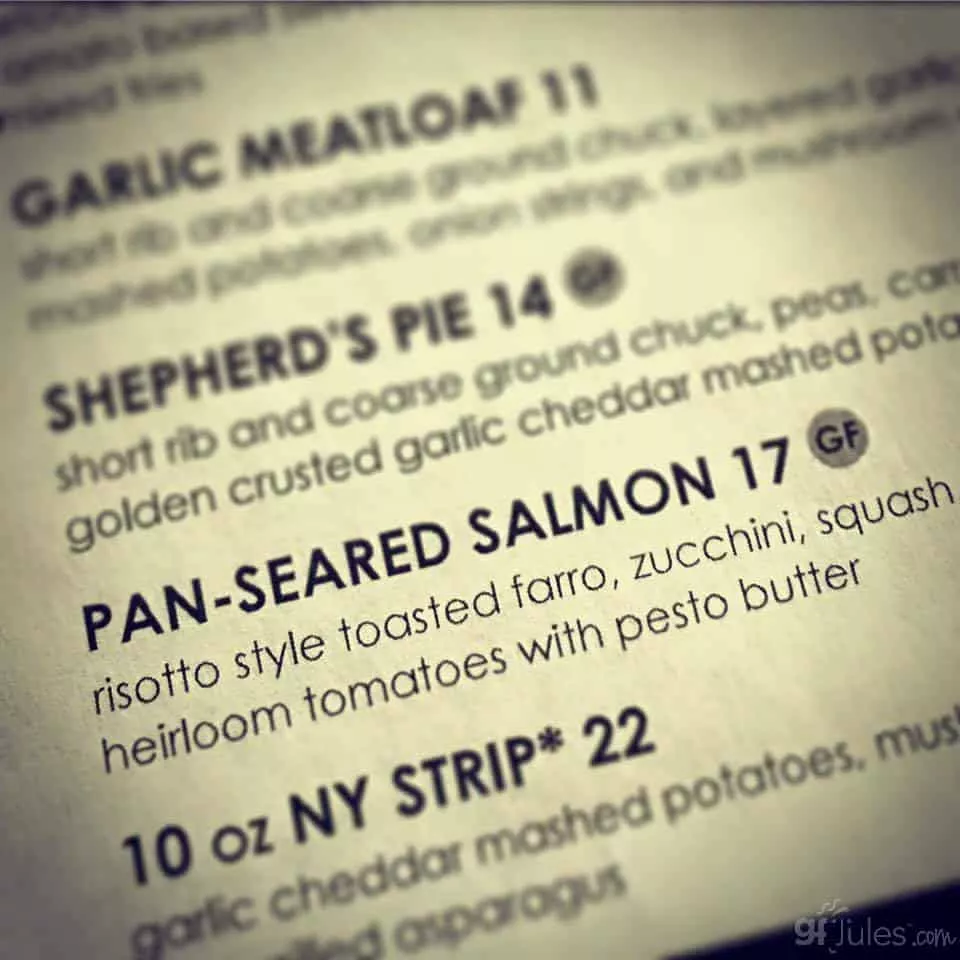
In addition to reading every label (ingredient and menu), and avoiding gluten as an ingredient, you need to be aware that anywhere gluten grains once were is a potentially dangerous place, as they can leave residue behind. So label or menu reading AND thorough cleaning to remove any crumbs or residue are the two essential components of staying safe and gluten free.
Furthermore, you need to realize that gluten is more than just an ingredient in food. Check with your pharmacist to ensure that all your prescriptions are gluten free, and read labels and call manufacturers if in doubt about filler ingredients in over the counter medicines, vitamins and supplements.
Avoid makeup, hand sanitizer and sunscreens with gluten if they’re going to be on your hands or near your mouth; also avoid playdoh for small children if they are gluten-free (make your own!), and think about your pet’s food — if it contains gluten and you are touching it, wash your hands and don’t let pets lick near your mouth after eating gluten-containing food.
What Does Gluten Cross-Contact Mean?
Before we get started, it’s important to understand why a fresh beginning is so essential to going gluten free successfully. Because gluten is just one tiny ingredient in lots of foods – it’s not something you can actually see. It can lurk in crumbs, sauces, pasta.
That means that anything in your kitchen that has touched these things (think toasters, pans, colanders, lunch boxes, utensils, counters, dish scrubbers, tea towels, etc.) may still have gluten on it or in it. When this gluten residue touches your gluten free food, gluten cross-contact occurs. (Some people call this gluten cross-contamination, but that’s not really accurate — that refers to bacteria.)
Studies have shown that anything more than 1/8th teaspoon of regular flour, or 1/350th of a slice of regular bread (up to 10mg gluten) can cause intestinal inflammation and even villous atrophy in celiacs. Many people find that they experience symptoms with even less gluten exposure.
Those with gluten intolerance, a condition characterized by adverse reactions and health risks when eating foods containing gluten, can manifest gastrointestinal symptoms after eating very small amounts of gluten but having tested negative for celiac disease.
Other studies attempting to find the threshold for prolonged gluten exposure formed the foundation for the FDA’s decision to restrict gluten free food labels to only those foods containing less than 20ppm gluten (approximate daily gluten consumption of 6mg gluten).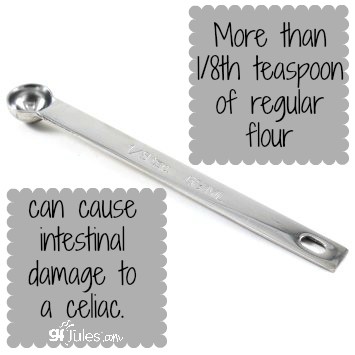
All this is to say that mere crumbs could harm someone with celiac disease or severe gluten sensitivity. That’s why we never simply pick the croutons off a salad, or use the same water for pasta that just boiled regular linguine. Following a strict gluten-free diet is crucial for managing celiac disease and related conditions.
Because of these health risks, you shouldn’t use pots, pans, condiments, grills, or appliances which may have such crumbs remaining from a non-gluten-free meal. These types of precautions when you’re going gluten free will go a long way toward protecting you and other gluten free family members from accidental gluten contamination.
How Do I Eat Gluten Free at Restaurants?
When you’re out at restaurants, for example, you need to be aware that a “gluten free menu” may not always be safe, and is going to require some more investigation on your part. Look for naturally gluten free options and ask basic questions like:
Is the fryer used for French fries also used for foods containing gluten (like chicken nuggets, for example)?
Studies have shown that French Fries from 60% of restaurants contained measurable amounts of gluten!
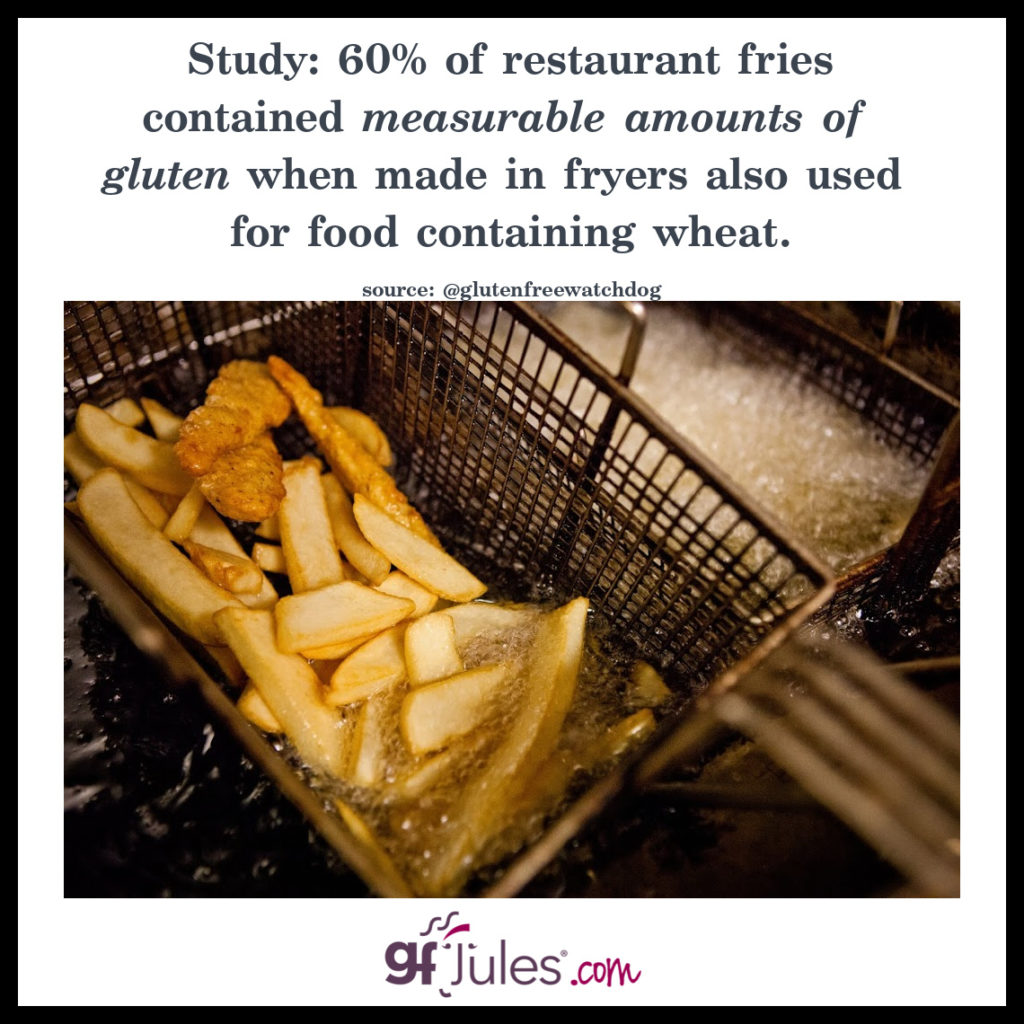
Even the pasta water for your gluten free noodles must be fresh, not used for gluten noodles first (a common practice in most restaurant kitchens).
Read more about safe shopping and eating out in my article linked here.
How Do I Make My Kitchen Gluten Free?
1. Clean Out and Reorganize to Make Your Pantry Gluten Free
Most of us could use a good old-fashioned spring cleaning in the pantry anyway, right? So use your gluten free transition as a kick in the pants to get you moving.
- Sit down with a big cardboard box and a trash bag. Put all the gluten-containing foods, not just those with obvious wheat flour, into the box. Put all the things that are expired or already opened in the trash bag.
- Now review the items with gluten in them. What are you really sad to see go? Make a list; this will form the beginning of your first gluten free grocery shopping list.
- Take the box to your local homeless shelter or food bank and pat yourself on the back: you have now done a good thing for yourself and for others.
- For the remaining gluten free foods, dedicate a section to your pantry or designate a cabinet to be entirely gluten free. If the whole house is going gluten free, well, that’s even easier!
- Thoroughly clean the surfaces of these cabinets and shelves. Make sure that no crumbs from the last bag of shredded wheat could find their way into your special gluten free foods. If you must store gluten- and gluten-free foods in the same cabinet or pantry section, gluten-free goes on top so no gluten crumbs will fall onto or into the gluten-free containers.
- If anyone in your family is not going gluten free, you’ll need to designate a separate section or a cabinet for gluten-containing items. If they’ll be stored close by, use large clear plastic lidded bins to keep any errant gluten crumbs or spills off the gluten free foods.
2. Do I Have to Buy a New Toaster?
If you have ever tried to clean a toaster—I mean really clean a toaster—you know that it is nearly impossible to remove every last crumb. Don’t even bother with this exercise in futility. Make an inexpensive, yet invaluable, investment in a new toaster. And some peace of mind. If you have other gluten eaters in your household, dedicate this new toaster to only gluten free foods and attach a fun sticker or colored electrical tape to the toaster for a friendly reminder!
3. Can Double-Dipping Spread Gluten?
If possible, use condiments that come from squeeze bottles. Otherwise, have a house rule that there is only one dip into a jar with any given utensil.
Bread crumbs hitchhike on peanut butter-laden knives, and can jump off and sit in the peanut butter jar. If the next person to use that peanut butter is gluten free, and those crumbs hitchhike their way back out on their knife, they’ll learn the hard way about the trouble with double dipping.
4. Do I Have to Replace My Pots and Pans to be Gluten Free?
Many people suggest that you buy all new pans when going gluten free. They suggest keeping dedicated pans and utensils only for gluten free meal prep. If this is possible with your budget and your kitchen storage, lucky you!
For most of us though, a whole new kitchen set (and finding a place to store it!) might not be practical. Instead, thoroughly examine any pans with worn surfaces, scratches or dents that could harbor food between uses. It’s probably time to replace them anyway, and going gluten free is the perfect excuse.
If you can separate any pans out for dedicated gluten free use, more power to you. I often recommend to my consulting clients that they identify these pans with brightly-colored electrical or duct tape wrapped around the handles.
If you simply cannot dedicate pans for exclusive gluten free use, don’t worry. Just be sure to scrub the pans well and then wash them in a dishwasher using all washing and drying cycles. Your pans will be cleaner-than-clean, and also safe.
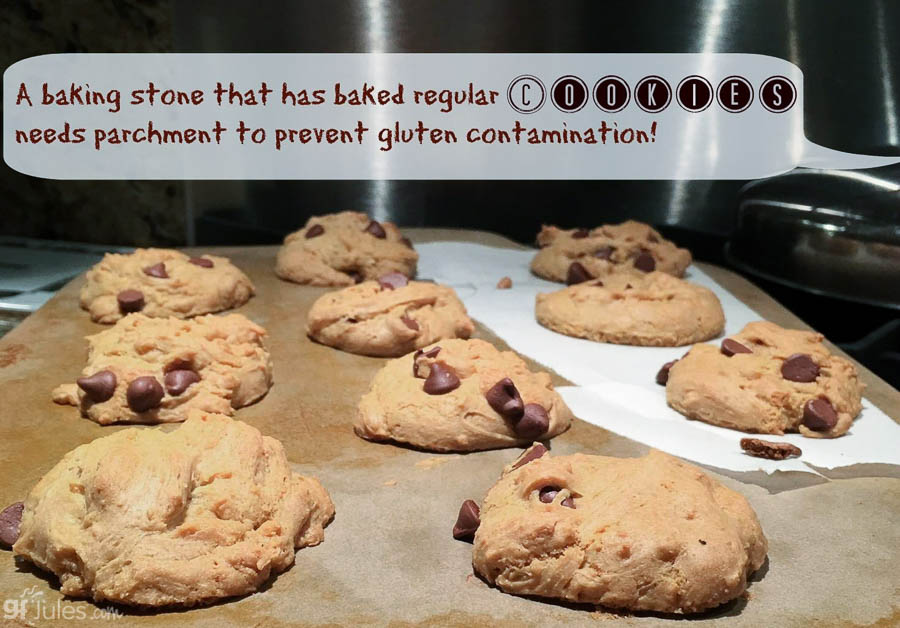
Another great way to save time on clean up and ensure you’re not subjecting yourself to unwanted gluten from old pans and baking stones is simply to cover everything with parchment.
I often say that parchment is my favorite baking accessory, and there’s more than one reason!
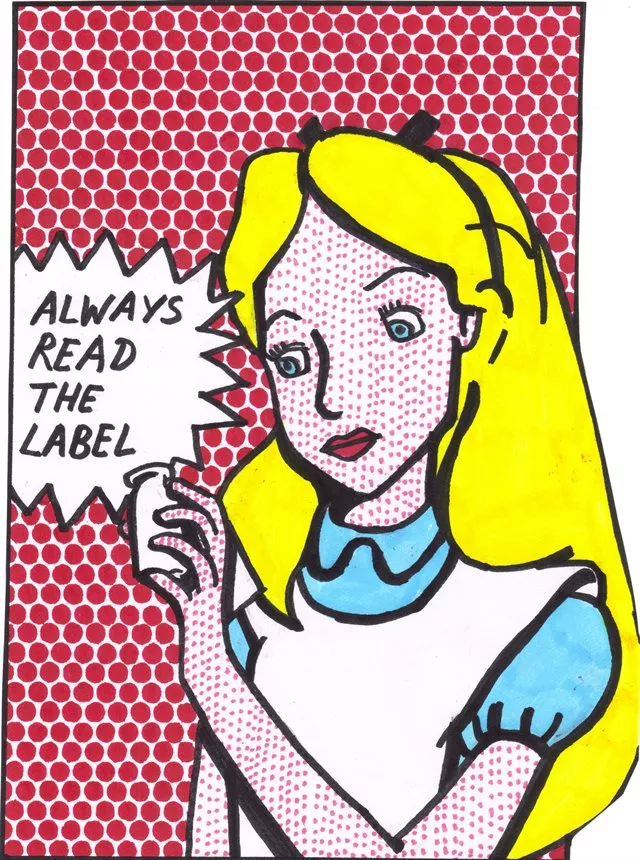
5. How Do I Read Labels for Gluten?
If you’re serious about going gluten free, you need to be serious about becoming an expert food label reader! When you clean your pantry, use the opportunity to get good at label terminology.
Get familiar with some of the many names for potential gluten sources like malt flavoring, malt vinegar or any unspecified thickeners, stabilizers, starches or flavorings.
If these ingredients are wheat-based, wheat must be noted on the ingredient label; however, if they are barley or rye-based, in the U.S., they are not specifically required to be called out as containing gluten on the label.
Bookmark, print or pin this list of 10 Surprising Places Gluten May be Hiding. It will serve you well! Did you know all 10?
Making gluten free life even more complicated, if you have a wheat allergy or choose to avoid the “gluten removed” wheat starch which is now becoming more popular in many foods, particularly pizza and bread, you cannot trust a “gluten free label. You MUST ask or look at a label to make sure it does not contain wheat, even if it says “gluten free.”
By the time you’ve reorganized your pantry, you will be an expert label reader. You’ll be able to fly down the grocery store aisles buying foods that you can trust!
Carry lists of gluten free grains and gluten containing ingredients as a reference to double-check when you run across something new or unique. You don’t have to spend more money on these lists; you can find lots of fact-checked content online. You can even carry my book with you, The First Year: Celiac Disease and Living Gluten Free.
If a food label has no gluten containing ingredients does that mean it’s gluten-free?
Since August of 2014, the FDA has required manufacturers who label their products as “Gluten Free” to ensure that their products contain less than 20ppm gluten. Some do a better job than others. The best way to be sure that a product is safe for your family is to buy products that are CERTIFIED gluten free by independent organizations like the Gluten Free Certification Organization (GFCO).
What about products without gluten ingredients listed but not claiming to be gluten free? Some are likely safe — they could be “naturally” gluten free or the manufacturer didn’t want to make a GF claim for one reason or another.
Other products may in fact contain gluten as part of something else listed. So how do you know? The best way to find out for sure is to contact the company directly through their website or customer service phone number. If they can’t give you a satisfactory answer, then opt against it; no food is worth the risk.

Remember that gluten could be in anything from salad dressing to chewing gum, so don’t assume a food is safe just because it doesn’t obviously contain flour.
Go here to learn more about how to shop for safe gluten free products.
6. Should I Buy Certified Gluten Free All Purpose Flour?
In cooking or baking gluten free, one of the hardest things to get used to is that the ingredient list is usually double that of most ordinary recipes. Don’t let that deter you!
The best tip for your new gluten free kitchen is to grab a big bag of my gfJules certified gluten-free all purpose gluten free flour (or mix a large batch with my alternative homemade recipe for those with other dietary restrictions, with individual ingredients that are each independently certified gluten free) and have it at the ready.
If the gluten free flour is ready to go, you have just cut the preparation time of your gluten free recipe in half, and you have cut back on possible excuses not to bake!
Plus, when you use my gfJules Flour, you don’t have to wonder if your recipes will turn out; you can rely on the fact that thousands of others choose it for their go-to flour for all their recipes — in fact, it’s been repeatedly voted #1 Gluten Free All Purpose Flour in the Gluten Free Awards!
A high quality, truly all purpose gluten free flour is the essential ingredient to going gluten free, happily. My works-in-everything flour will allow you to make all your old favorite recipes again!
Feel free to try a sample of my gfJules flour for only $7.50. Trying is believing that gluten-free foods can taste just as good (or better!) than those with gluten!
7. Can Everyone Eat the Same Gluten-Free Food?
If part of your family is going gluten free, everyone in the family should be eating gluten free meals at home, together. For people with celiac disease or going gluten free for other medical reasons, adhering to a strict gluten-free diet is essential to avoid serious health complications, but when everyone in your family eats gluten free together, it not only saves money, it makes the gluten-free folks feel like they’re not left out.
Why You Shouldn’t Have Regular FLOUR in Your Kitchen
I understand buying your non-gluten-free child occasional gluten-containing ready-made foods. Snacks and regular sandwich bread for packed school lunches means more of the yummy homemade gluten-free bread for you, right? Plus, your kid might not even eat the sandwich, since you aren’t there to make sure they eat it before the pudding!
But otherwise, there is honestly no reason why you should have any gluten flour in your kitchen any more. It is far too easy for such a light ingredient like flour to contaminate other things in the kitchen. Plus, it’s cheaper, easier, more efficient and more conducive to family dining if you can all enjoy the same food. And lick the bowl together.

Once everyone tastes the delicious and easy foods available on your diet (trust me! just look through all the amazing gluten-free recipes on my site to get you started!), there will be no excuses! Furthermore, one of the easiest ways to stay on a gluten free diet is to have the support of your family and friends. If your family eats different foods at every meal, it will be much harder for you to stay on a gluten free diet and to remain positive about your new lifestyle.
But Isn’t a Gluten-Free Diet Unhealthy For People Who Don’t Have to Eat Gluten-Free?
You’ll surely hear some folks say that a gluten-free diet is unhealthy for those who don’t have to eat gluten free for medical reasons. This misconception is based on the nutritional content of most processed gluten-free foods.
Gluten-free snacks and pre-packaged items like cookies, pretzels, chips, bars, cereals and the like DO often contain more sugar and/or fat than their wheat-based counterparts because most manufacturers opt for cheaper gluten-free flours with odd flavors or grittiness that needs to be masked by extra sugar or oils.
But if you steer clear of such processed foods, you’ll save money and avoid the nutritional void offered by products like these. Instead opt for adding more whole foods to your diet — shop the perimeter of the grocery store and stock up on vegetables, fruits, legumes (beans) and nuts, as well as unprocessed meat, seafood or organic tofu for protein.
If these form the foundation of your family’s gluten-free diet, everyone will eat well, in fact probably better than before the family started reading nutritional labels and removing gluten from their diets.

To ensure that this lifestyle is one you can maintain, don’t deprive yourself or your family of fresh gluten-free breads, cakes, cookies and treats … just bake them yourself! That way you can control what goes into them and the deliciousness that comes out!
Gluten free baked goods like these should be the special extras that you add to your new whole food-based diet, meaning that your family will eat a nutritionally balanced diet but not feel deprived of breads and treats — a true recipe for long-term success.
Where Can I Find More Information About Gluten Free Life?
Do not go gluten-free before being tested for celiac disease by a physician; if you suspect you have non-celiac gluten sensitivity, consider consulting a physician and a registered dietitian.
Download your complimentary copy of my New to Gluten Free e-book. Or buy the paperback or electronic version of my award-winning paperback: The First Year: Celiac Disease and Living Gluten Free.

Pin these infographics for later!
